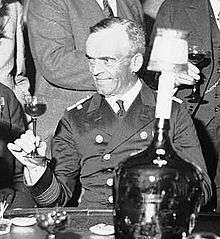Otto Schniewind
| Otto Schniewind | |
|---|---|
 Schniewind in 1933 | |
| Born |
14 December 1887 Saarlouis |
| Died |
26 March 1964 (aged 76) Linz am Rhein |
| Allegiance |
|
| Service/branch |
|
| Years of service | 1907–45 |
| Rank | Generaladmiral |
| Unit |
SMS Leipzig SMS Augsburg SMS Magdeburg |
| Commands held | cruiser Köln |
| Battles/wars | |
| Awards | Knight's Cross of the Iron Cross |
Otto Schniewind (14 December 1887 – 26 March 1964) was a General Admiral with the Kriegsmarine during World War II and a recipient of the Knight's Cross of the Iron Cross (German: Ritterkreuz des Eisernen Kreuzes). The Knight's Cross of the Iron Cross was awarded to recognise extreme battlefield bravery or successful military leadership.
Career
Schniewind entered the Kaiserliche Marine in 1907 as a cadet. During the First World War he served as a commander of torpedoboats. When the German fleet surrendered to the British he commanded a squadron of torpedo boats, with this he partook in the Scuttling of the German fleet in Scapa Flow, after which he was taken prisoner by the British.
After being released Schniewind continued to serve in the Reichsmarine. From 1925 to 1926 he served as adjutant to the Minister of War Otto Gessler. In 1932 Schniewind became captain of the light cruiser Köln. In 1934 Schniewind was appointed to another staff function. He was promoted to rear admiral in 1937 and to vice admiral in 1940.
He served as Chief of Staff of the Seekriegsleitung from 1938 to 1941. After the sinking of the Bismarck Schniewind was appointed as successor to Günther Lütjens who was lost with the ship. In 1943 Schniewind became commander of Marinegruppenkommandos Nord. On March 1, 1944 Schniewind was promoted to Generaladmiral. On July 30, 1944 Schniewind was relieved of command and for the duration of the war he saw no further employment.
After the War he was arrested and prosecuted during the High Command Trial for his role in the invasion of Norway (Operation Weserübung) but he was acquitted, after which he was released from captivity. From 1949 to 1952 he served with the Naval Historical Team in Bremerhaven.
Awards
- Iron Cross (1914)
- 2nd Class
- 1st Class (5 January 1918)[1]
- Friedrich-August-Kreuz, 2nd and 1st Class
- Honour Cross of the World War 1914/1918
- Order of the Sword, Commander 2nd Class (Sweden) (30 June 1936)[1]
- Wehrmacht Long Service Award 4th to 1st Class (2 October 1936)[1]
- Memel Medal (26 October 1936)[1]
- Order of St. Sava 2nd Class (1 June 1939) (Yugoslavia)[1]
- Order of the Crown of Italy, Grand Officer (23 September 1939)[1]
- Order of Naval Merit (Spain) in White (21 August 1939)[1]
- Clasp to the Iron Cross (1939) 2nd and 1st Class
- Knight's Cross of the Iron Cross on 20 April 1940 as Vizeadmiral and chief of staff of the Seekriegsleitung in the OKM[2][Note 1]
- Order of the Sacred Treasure 1st Class (Japan)[1]
- High Seas Fleet Badge (30 July 1944)[1]
Notes
- ↑ According to Scherzer as Chef des Stabes der Seekriegsleitung und Chef des Marinekommando Amt im OKM.[3]
References
Citations
Bibliography
- Dörr, Manfred (1996). Die Ritterkreuzträger der Überwasserstreitkräfte der Kriegsmarine—Band 2: L–Z [The Knight's Cross Bearers of the Surface Forces of the Navy—Volume 2: L–Z] (in German). Osnabrück, Germany: Biblio Verlag. ISBN 978-3-7648-2497-6.
- Fellgiebel, Walther-Peer (2000) [1986]. Die Träger des Ritterkreuzes des Eisernen Kreuzes 1939–1945 — Die Inhaber der höchsten Auszeichnung des Zweiten Weltkrieges aller Wehrmachtteile [The Bearers of the Knight's Cross of the Iron Cross 1939–1945 — The Owners of the Highest Award of the Second World War of all Wehrmacht Branches] (in German). Friedberg, Germany: Podzun-Pallas. ISBN 978-3-7909-0284-6.
- Nietrug, Gerd (2004). Die Ritterkreuzträger des Saarlandes 1939 – 1945 [The Knight's Cross Bearers of the Saarland 1939 – 1945] (in German). Zweibrücken, Germany: VDM Nickel. ISBN 978-3-925480-93-5.
- Range, Clemens (1974). Die Ritterkreuzträger der Kriegsmarine [The Knight's Cross Bearers of the Navy]. Stuttgart, Germany: Motorbuch Verlag. ISBN 978-3-87943-355-1.
- Scherzer, Veit (2007). Die Ritterkreuzträger 1939–1945 Die Inhaber des Ritterkreuzes des Eisernen Kreuzes 1939 von Heer, Luftwaffe, Kriegsmarine, Waffen-SS, Volkssturm sowie mit Deutschland verbündeter Streitkräfte nach den Unterlagen des Bundesarchives [The Knight's Cross Bearers 1939–1945 The Holders of the Knight's Cross of the Iron Cross 1939 by Army, Air Force, Navy, Waffen-SS, Volkssturm and Allied Forces with Germany According to the Documents of the Federal Archives] (in German). Jena, Germany: Scherzers Militaer-Verlag. ISBN 978-3-938845-17-2.
| Military offices | ||
|---|---|---|
| Preceded by none |
Chief of Staff of the Seekriegsleitung October 1938 – 10 June 1941 |
Succeeded by Admiral Kurt Fricke |
| Preceded by Admiral Günther Lütjens |
Chief of Fleet of the Kriegsmarine June 1941 – July 1944 |
Succeeded by Admiral Wilhelm Meendsen-Bohlken |